Event-Based Automations
Event-Based Automations are automations that work automatically when a specific event is triggered. For example, actions such as clicking a button or creating a task can start these automations. These types of automations make the process more efficient and speed up workflows by minimizing manual intervention.
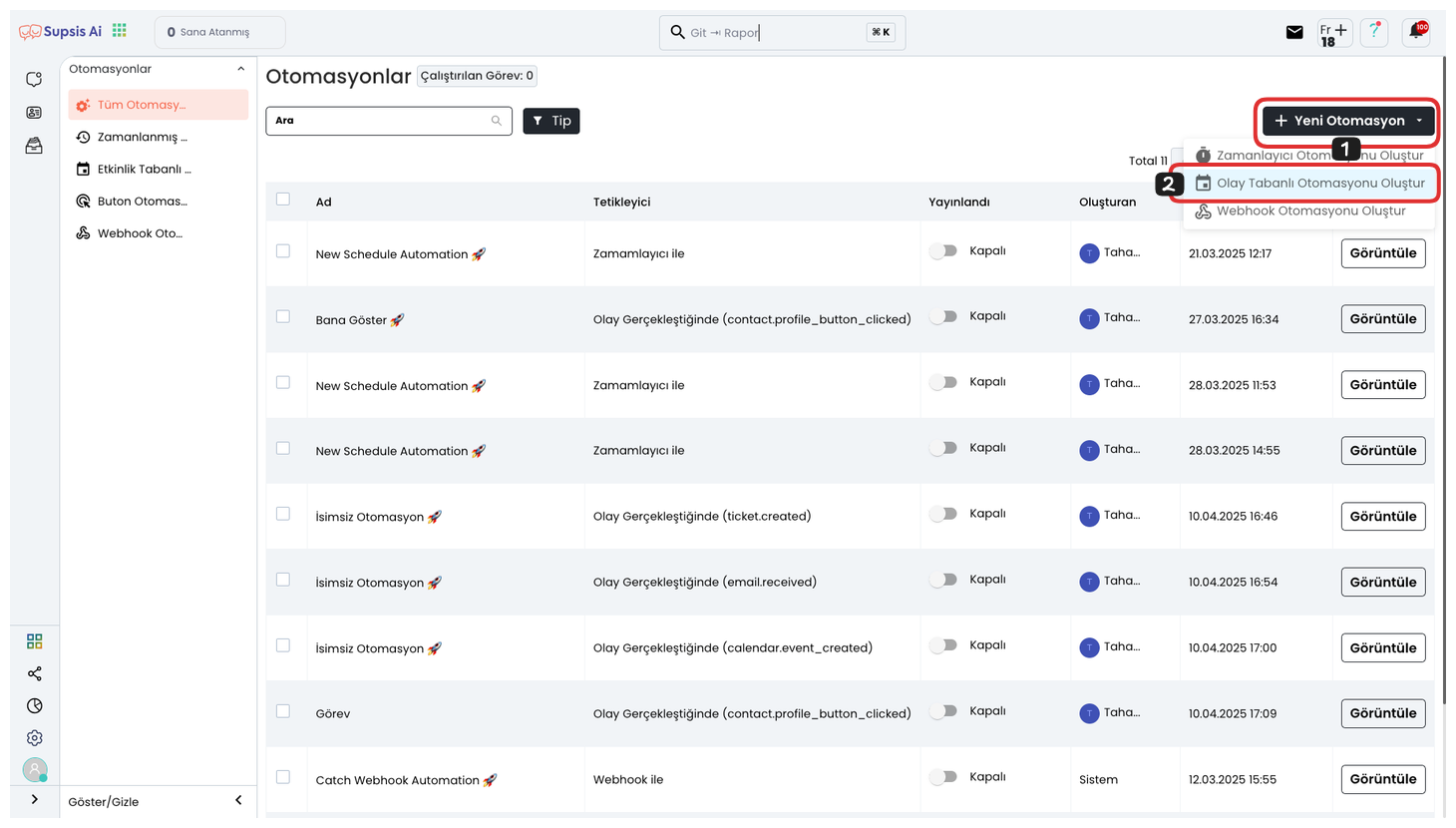
Click the "New Automation" button from the top right, then click the "Create Event-Based Automation" button from the opened area. In the opened area, decide which event will trigger the automation and select this event.
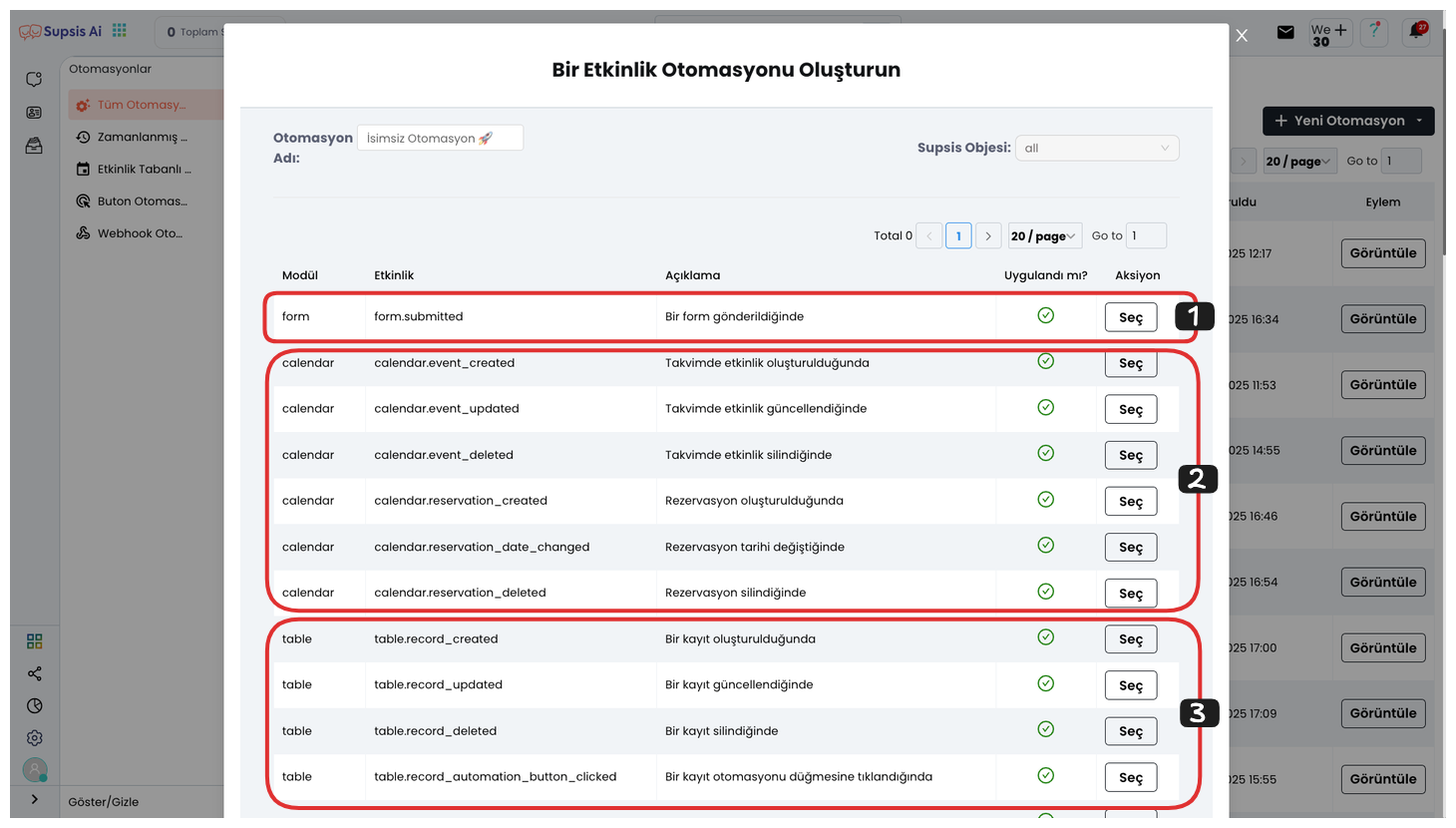
Event Automation Elements:
- Form
- Calendar
- Table
1-) Form
Form Automations are automations that are automatically triggered when a form is created. These types of automations start certain operations based on form data after users fill out a form. For example, when an application form is filled out, actions such as sending emails, adding records to the database, or triggering other actions can be triggered based on the form content. Form automations save time and automate operations to provide an efficient workflow.
2-) Calendar
Calendar Automations are automations that are triggered based on changes made in the calendar module. For example, when an event is created, when a reservation date is changed, or when another change is made in the calendar, these automations are activated. These types of automations automate and track calendar-related operations such as events, appointments, or reservations. Thanks to calendar automations, timely reminders, notifications, or other actions can be triggered without the need for manual intervention.
3-) Table
Table Automations are automations that are triggered based on changes made in the Table module. For example, when a new record is created in a table, when an existing record is updated, or when it is deleted, these automations are activated. Table automations automate data management and allow you to track changes in the database. This way, specific actions can be taken, notifications can be sent, or other operations can be performed on the data without the need for manual processing.
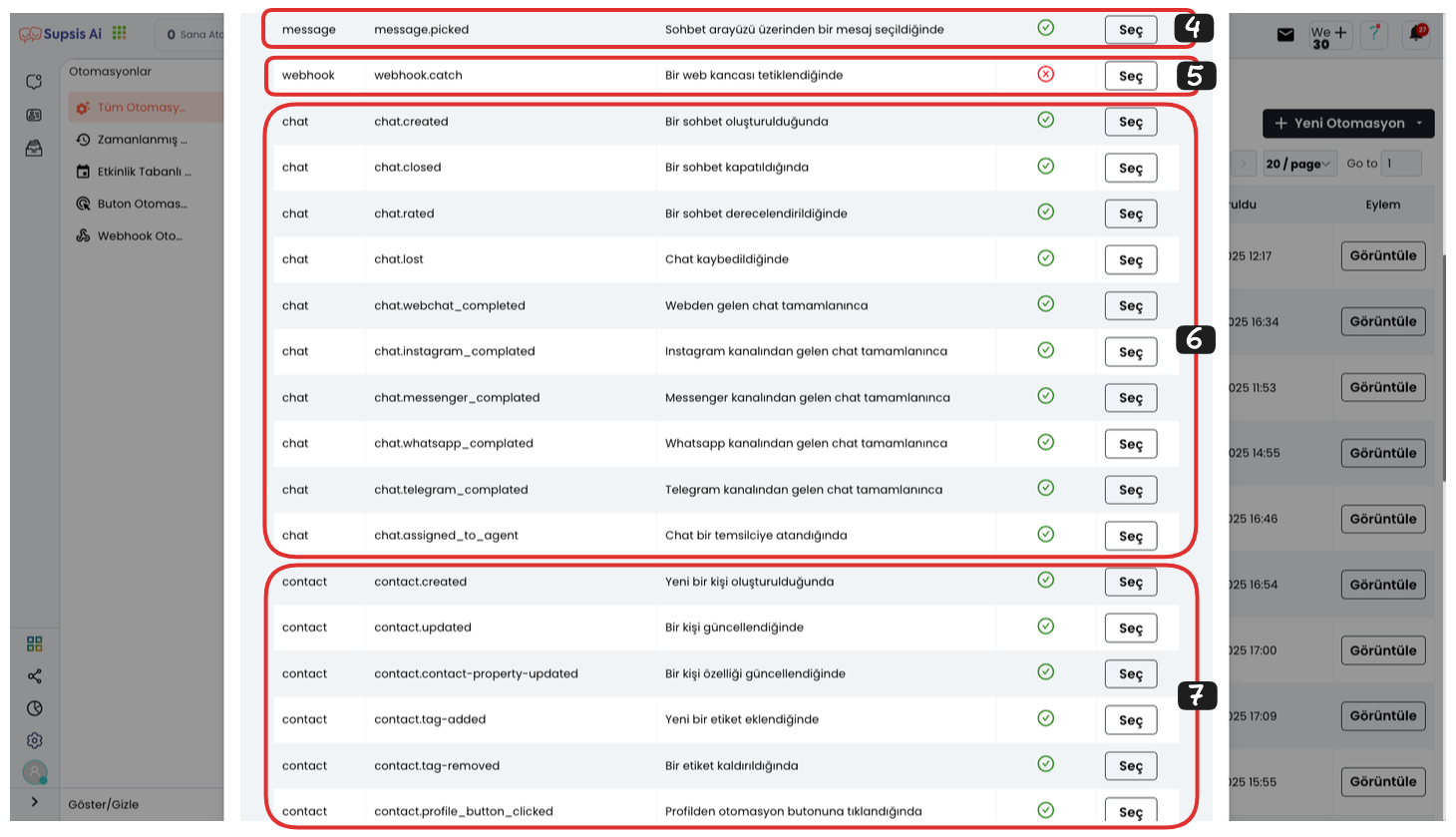
- Message
- Webhook
- Chat
- Contacts
4-) Message
Message Automations are automations that are triggered when a text is selected in the chat screen. These types of automations usually come into play after users interact with a specific message or text. For example, if a user types a keyword, this automation can automatically work to give a specific response, perform an operation, or perform another action. This makes the chat experience more dynamic and interactive, and also automates customer service.
5-) Webhook
Webhook Automations are automations that come into play when a specific webhook is triggered. Webhook receives data or events from an external system and starts an automatic process. These types of automations are usually used when data is received from an API, triggered by an external service, or when interacting with another system. For example, when a payment process is completed, when a customer record needs to be updated, or when a new ticket is created, webhook automations become active and perform predetermined actions.
6-) Chat
Chat Automations are automations that come into play when an event occurring in the chat menu is triggered. These automations allow you to take automatic actions related to specific stages of the chat. For example, they can work automatically when a chat is created, when a chat is lost, or when a chat is assigned to an agent. These types of automations speed up chat processes and reduce manual intervention, thus ensuring that customer interactions are managed faster and more efficiently.
7-) Contacts
Contact Automations are automations that come into play when any event related to contacts is triggered. These types of automations work automatically when a contact record is created, updated, or deleted. When contact data changes, these automations trigger specific actions, making data management more dynamic and efficient. For example, when a new contact record is created, a follow-up task can be started, or when information about an existing contact is updated, a notification can be sent automatically. These automations optimize data accuracy and customer interactions.
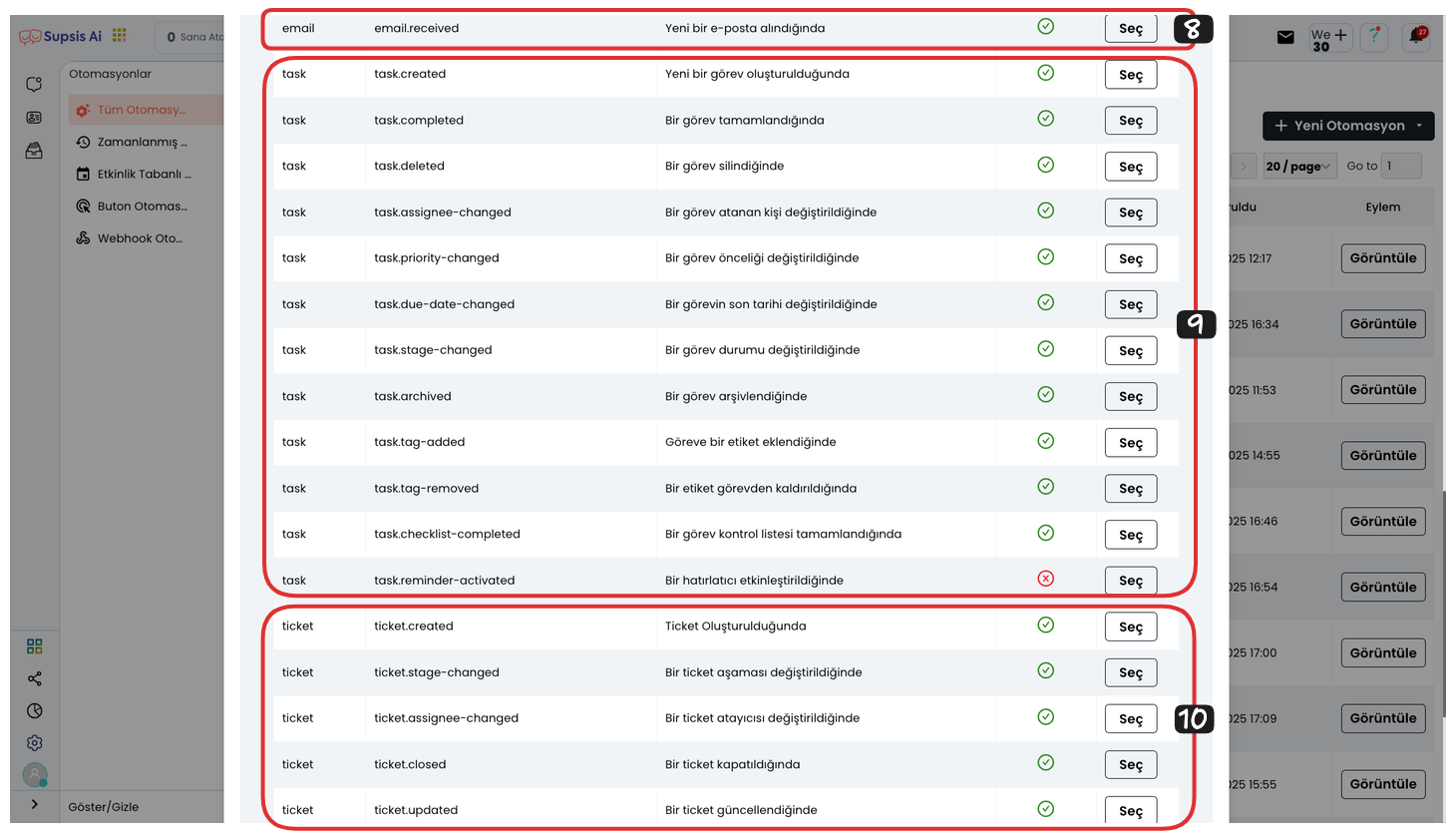
- Task
- Ticket
8-) Email
Email Automations are automations that are automatically triggered when an email is received. This automation type allows you to start specific actions based on an incoming email message. For example, when a new email is received, the system can automatically create a task related to this email, send a notification, or direct it to the relevant department. Email automations are used to speed up customer support processes and make email-based interactions more efficient.
9-) Task
Task Automations are automations that are triggered when a change occurs in the Task module. These types of automations allow you to automate operations such as creating, updating, or completing tasks. For example, when a task is created, when a task is completed, or with any change made to a task, specific actions can be triggered. Task automations are useful for monitoring, tracking, and timely completion of business processes. These automations ensure that your team works more efficiently and automates task management.
10-) Ticket
Ticket Automations are automations that are triggered as a result of changes occurring in the Ticket module. These types of automations ensure that specific actions are taken automatically when a ticket (support request) is created, updated, or closed. For example, when a customer creates a new support request, an agent can be assigned to this ticket or a specific operation can be performed. When a ticket is updated, notifications can be sent to relevant parties by triggering status changes or responses. When a ticket is closed, the workflow can be completed as resolved. These automations speed up customer support processes, reduce error rates, and provide a more efficient support experience.
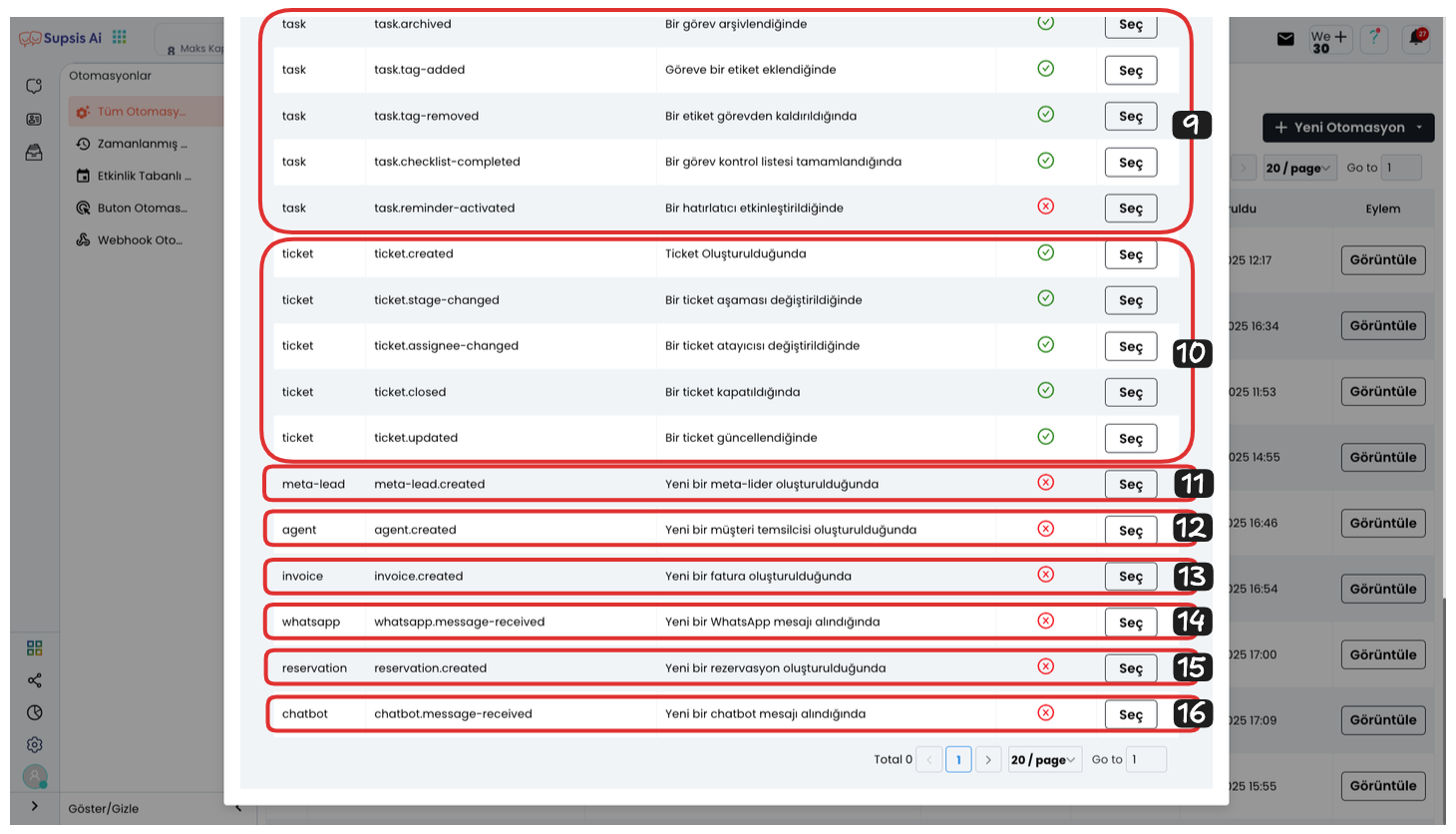
- Meta-Lead
- Agent
- Invoice
- Reservation
- Chatbot
11-) Meta-Lead
Meta-Lead Automations are automations that are triggered with new lead (potential customer) information coming from Meta platforms. This automation type comes into play when a new lead is created from Meta platforms (such as Facebook, Instagram). For example, when a person responds to a campaign through a Meta platform, this data is automatically saved to the system and a series of operations can be started. Meta-Lead Automations are usually used when a specific action needs to be taken for this new lead; for example, assigning a customer representative, transferring lead data to the CRM system to start follow-up, or sending an automatic follow-up email can be automated. These automations speed up lead tracking and ensure that processes progress more efficiently.
12-) Agent
Agent Automations are automations that are triggered when a new customer agent is created. This automation type starts a specific series of operations or actions when an agent is registered to the system, for example, when a new employee is added. Agent Automations usually include automating operations related to the agent, such as assigning tasks to the new agent, sending training materials, or automatically defining appropriate access and permissions in the system. These types of automations ensure that agents are quickly integrated into the system, thus increasing operational efficiency within the company. Additionally, it helps make work processes more organized and efficient by creating special tasks, notifications, and directions for agents.
13-) Invoice
Invoice Automations are automations that are triggered only when a new invoice is created. These automations allow you to automatically start a specific series of operations the moment an invoice is issued. For example, when an invoice is created, you can automate processes such as sending a payment reminder, forwarding invoice information to the relevant department, or starting reporting operations related to a specific invoice. Invoice Automations speed up companies' financial transactions, reduce error rates, and ensure that financial processes are managed more systematically.
14-) WhatsApp
WhatsApp Automations are automations that are triggered only when a new WhatsApp message is received. These types of automations allow you to automatically start specific operations through incoming messages. For example, when a customer sends a message via WhatsApp, you can send automatic responses, save customer information, or create a task based on the customer's request. WhatsApp Automations allow you to manage customer interactions quickly and efficiently, thus automating and speeding up your business's customer service processes.
15-) Reservation
Reservation Automations are automations that are triggered only when a new reservation is created. These types of automations automate processes related to the creation of reservations. For example, when a customer makes a new reservation, you can automatically send confirmation emails, add to calendar, or send notifications to the relevant department. Reservation Automations speed up your business's reservation processes and increase efficiency by reducing error risks.
16-) Chatbot
Chatbot Automations are automations that are triggered only when a new chatbot message is received. These types of automations automate your processes by responding to user messages coming through the chatbot. For example, when a user contacts the chatbot, automatic responses can be given, information can be provided to the user, or another action can be triggered. Chatbot Automations make customer interactions faster and more efficient, thus optimizing your business's customer service.